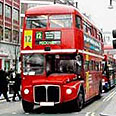
London haredim considering move
Overcrowding, high housing costs in London may leave ultra-Orthodox neighborhood of Stamford Hill for new town about an hour north of city
One of Europe's largest Orthodox communities needs new homes for its young families because of a shortage of affordable housing in London, and they have set their sights on a 1960s purpose-built city - Milton Keynes a city 80 km (50 miles).
Ultra-Orthodox Jews, known in Hebrew as "haredim," have lived in Stamford Hill since World War II. Now, there are around 20,000 haredim in the neighborhood in northeast London.
"(Stamford Hill) is bulging at the seams," said Jose Martin, who lives in Stamford Hill and worked as a liaison officer for the haredi community with the Hackney local council.
Bizarre choice
Many traditionally insular haredi Jews do not watch television or use the Internet. Many men wear beards, black coats and wide-brimmed hats and married women cover their heads.
The choice of Milton Keynes -- north of London and known for its functional modern architecture and large shopping district -- may seem unusual.
The city's high-tech and consumerist image seems at odds with the haredim's conservative and spiritual lifestyle, while its modern design sets it apart from other cities.
A popular novel co-written by author Terry Pratchett said that Milton Keynes "was built to be modern, efficient, healthy and, all in all, a pleasant place to live. Many Britons find this amusing."
It is precisely these qualities, however, that have attracted Stamford Hill's haredim.
"Milton Keynes scored the highest (in a community poll) for environment, accessibility and house prices," Rabbi Abraham Pinter told Reuters.
Looking north
A shortage of houses and steadily climbing prices are a problem for many where the construction of new houses in 2001 fell to its lowest level since World War II.
Last month, the housing minister said the country needed to increase the pace of house building to 200,000 new homes a year from its current 140,000 over the next 10 years.
The problem is particularly acute for the haredim, a community that grows 8 percent a year.
Haredi families in Stamford Hill have on average 5.9 children, almost 2.5 times the average for England and Wales, and many families live in overcrowded apartments.
"We have got a lot of kids, you know," said Ben Fisher, a haredi factory worker. But he said he would not be among the first to move out. "If a lot of people move, if it's an established community, then I'll move."
Making plans
The plans are still in the very early stages: The Union of Orthodox Hebrew Congregations has expressed interest in buying land for 300 family homes on a site in Milton Keynes.
The Union, which represents the haredim, will be able to make a formal planning application once the master plan for the Tattenhoe Park site - which will include several residential developments - is approved by city authorities.
"It very much depends on what the planning authorities will say. We are in their hands," said Shimon Cohen, a spokesman for the haredi community group behind the Milton Keynes project.
Stamford Hill's haredim now have a year to raise the money for the construction of the new homes. Some of the houses will be put on sale, while others will be rented out.
Livingstone: willing to help
Pinter estimates there are around 50,000 haredi Jews living in Britain, although he said that definitions of haredim vary widely. There are some 267,000 Jews living in Britain, according to latest figures from the Office for National Statistics.
London Mayor Ken Livingstone said he had met with the Union of Orthodox Hebrew Congregations to discuss the issue.
"(I) will do all I can to find a solution that ensures that the needs of London's Orthodox Jewish community are met in future years," he told Reuters, adding that one solution could be to relocate the community within the capital.
The haredim would prefer to build homes outside London -- this would allow young families to expand, something it is difficult to do in the established community, Pinter said.
"People would be looking for a different quality of life or would want to live in a less urban area," he said.
Cows and ants
Martin said families would have bigger houses and gardens in Milton Keynes. "Their children will see cows and ants for the first time," she said.
If the move goes ahead, it will involve special conditions, Cohen said. For example, those who want to relocate will have to do so in groups of at least three or four families to constitute a praying community, which requires 10 men over the age of 13.
The arrival of 300 haredi families will also be a new experience for Milton Keynes, home to just 466 Jews.
Even if the move does happen, Stamford Hill with its kosher shops and synagogues will remain a haredi heartland, residents say.
"It's a very mixed area, mixed and harmonious," said shopkeeper Eli Berry, who arrived from Israel 15 years ago and who will not move out.
Ultra-Orthodox Jews came to Stamford Hill from central and eastern Europe before, during and after World War II and were later joined by haredim mostly from India, North Africa, Israel, Russia, Yemen and France.
"The Jewish community will stay (in Stamford Hill) forever more," said Cohen.










